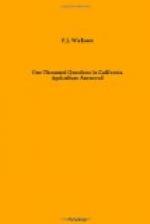The purification naturally cannot be very great, and if milk is produced in unsanitary fashion, running through the separator will do little, if any, good. Nevertheless, the separator does remove more than just the solid particles of dirt. The purifying comes by leaving behind the separator slime, so called, the slimy material left behind after a good deal of milk has been run through. In fact, some creameries separate milk, only to mix milk and cream again, largely for the purpose of removing the impurities found in the slime. In this slime are not only the impurities that fall into the milk, but also some of the fibrous matter that is part of the milk, and this gathers, being pulled out by gravity as are the fat particles, it seems to gather with it a few more bacteria than remain in the milk itself. Material in real solution, as sugar is in solution in water, naturally is practically unaffected by separation. You are, therefore, right to the extent that you cannot produce unsanitary milk and clean it with the separator, but your neighbor is right to the extent that the separator does remove some impurities and is used just for that purpose. There is also in the dairy trade a centrifugal milk clarifier which is constructed in somewhat similar manner to a cream separator, but acts differently on the milk in not interfering with cream rising by gravity when separated cream and milk are mixed after cleaning.
Butter Going White.
I bought some butter and during the warm weather it melted. About 40 or 50 per cent was white, while the balance was yellow and went to the top. When the butter remelted, the yellow portion melted, leaving the white portion retaining its shape. The white portion did not taste like ordinary butter. The butter made from our cows’ cream melted at a higher temperature, but did not have a white portion. Why did our butter not act like the creamery butter?
Samples of butter have occasionally been sent to this office that have turned white on the outside, and since the white part has a very disagreeable, tallowy flavor, people think that tallow or oleomargarine has been mixed with it, but we have never been able to find any foreign substance in any of the samples. We have found that some of the best brands of butter will turn white first on the outside and the white color will gradually go deeper if the butter is exposed to a current of air or if left in the sun a short time — F. W. Andreason, State Dairy Bureau.
What Is “Butter-fat?”
I would like to know what “butter-fat” means. I have asked farmers this question and no one seems to know. I suppose all parties dealing with creameries understand what the standard of measure or weight of butter-fat is, but it is my guess that there are thousands of farmers whom, if they were asked this question, would not know. We, of course, know that butter is sold by the pound and cream by the pint, quart or gallon, but what is butter-fat sold by?




